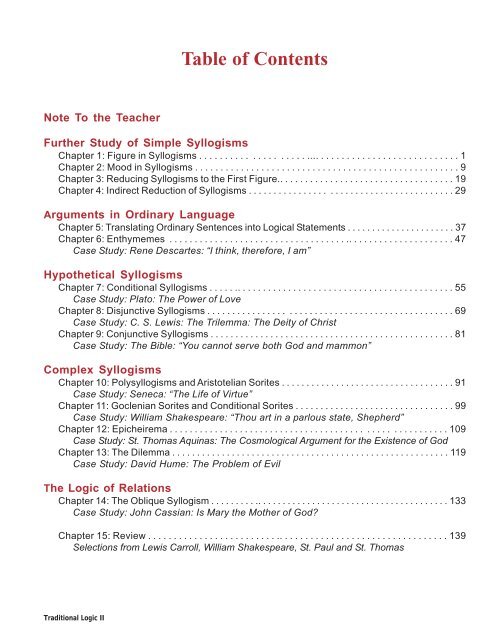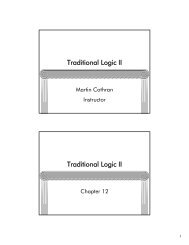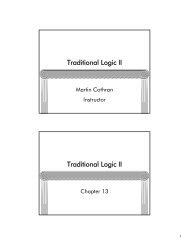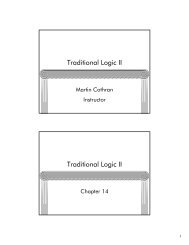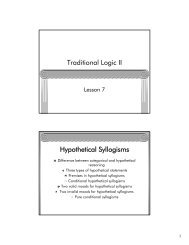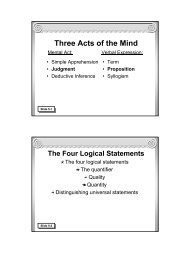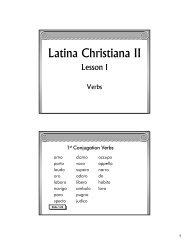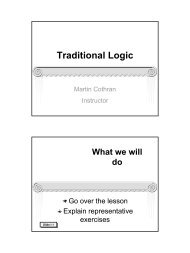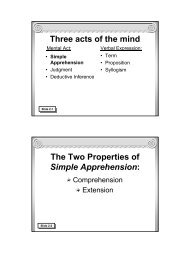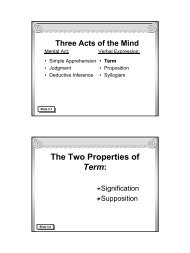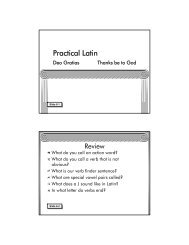Table of Contents - Memoria Press
Table of Contents - Memoria Press
Table of Contents - Memoria Press
Create successful ePaper yourself
Turn your PDF publications into a flip-book with our unique Google optimized e-Paper software.
<strong>Table</strong> <strong>of</strong> <strong>Contents</strong><br />
Note To the Teacher<br />
Further Study <strong>of</strong> Simple Syllogisms<br />
Chapter 1: Figure in Syllogisms . . . . . . . . . . . . . . . . . . . . .... . . . . . . . . . . . . . . . . . . . . . . . . . . . 1<br />
Chapter 2: Mood in Syllogisms . . . . . . . . . . . . . . . . . . . . . . . . . . . . . . . . . . . . . . . . . . . . . . . . . . . . 9<br />
Chapter 3: Reducing Syllogisms to the First Figure.. . . . . . . . . . . . . . . . . . . . . . . . . . . . . . . . . . . 19<br />
Chapter 4: Indirect Reduction <strong>of</strong> Syllogisms . . . . . . . . . . . . . . . . . . . . . . . . . . . . . . . . . . . . . . . . . 29<br />
Arguments in Ordinary Language<br />
Chapter 5: Translating Ordinary Sentences into Logical Statements . . . . . . . . . . . . . . . . . . . . . . 37<br />
Chapter 6: Enthymemes . . . . . . . . . . . . . . . . . . . . . . . . . . . . . . . . . . . .. . . . . . . . . . . . . . . . . . . . . 47<br />
Case Study: Rene Descartes: “I think, therefore, I am”<br />
Hypothetical Syllogisms<br />
Chapter 7: Conditional Syllogisms . . . . . .. . . . . . . . . . . . . . . . . . . . . . . . . . . . . . . . . . . . . . . . . . . 55<br />
Case Study: Plato: The Power <strong>of</strong> Love<br />
Chapter 8: Disjunctive Syllogisms . . . . . . . . . . . . . . . . . . . . . . . . . . . . . . . . . . . . . . . . . . . . . . . . . 69<br />
Case Study: C. S. Lewis: The Trilemma: The Deity <strong>of</strong> Christ<br />
Chapter 9: Conjunctive Syllogisms . . . . . . . . . . . . . . . . . . . . . . . . . . . . . . . . . . . . . . . . . . . . . . . . . 81<br />
Case Study: The Bible: “You cannot serve both God and mammon”<br />
Complex Syllogisms<br />
Chapter 10: Polysyllogisms and Aristotelian Sorites . . . . . . . . . . . . . . . . . . . . . . . . . . . . . . . . . . . 91<br />
Case Study: Seneca: “The Life <strong>of</strong> Virtue”<br />
Chapter 11: Goclenian Sorites and Conditional Sorites . . . . . . . . . . . . . . . . . . . . . . . . . . . . . . . . 99<br />
Case Study: William Shakespeare: “Thou art in a parlous state, Shepherd”<br />
Chapter 12: Epicheirema . . . . . . . . . . . . . . . . . . . . . . . . . . . . . . . . . . . . . . . . . . . . . . . . . . . . . . . 109<br />
Case Study: St. Thomas Aquinas: The Cosmological Argument for the Existence <strong>of</strong> God<br />
Chapter 13: The Dilemma . . . . . . . . . . . . . . . . . . . . . . . . . . . . . . . . . . . . . . . . . . . . . . . . . . . . . . . . 119<br />
Case Study: David Hume: The Problem <strong>of</strong> Evil<br />
The Logic <strong>of</strong> Relations<br />
Chapter 14: The Oblique Syllogism . . . . . . . . . .. . . . . . . . . . . . . . . . . . . . . . . . . . . . . . . . . . . . . . . 133<br />
Case Study: John Cassian: Is Mary the Mother <strong>of</strong> God<br />
Chapter 15: Review . . . . . . . . . . . . . . . . . . . . . . . . . .. . . . . . . . . . . . . . . . . . . . . . . . . . . . . . . . . 139<br />
Selections from Lewis Carroll, William Shakespeare, St. Paul and St. Thomas<br />
Traditional Logic II
Note to the Teacher<br />
To the Teacher<br />
The two<br />
books together<br />
constitute a<br />
complete<br />
course in<br />
formal logic at<br />
the junior and<br />
senior high<br />
school levels.<br />
What This Book Covers. This book is a continuation <strong>of</strong><br />
Traditional Logic, Book I: An Introduction to Formal Logic, and<br />
presupposes a knowledge <strong>of</strong> the material in that book. The two books<br />
together constitute a complete course in formal logic at the junior<br />
and senior high school levels.<br />
Book I covers the three acts <strong>of</strong> the mind involved in logic: simple<br />
apprehension, judgement and deductive inference. In this book, we<br />
continue the study <strong>of</strong> deductive inference with the treatment <strong>of</strong> figure<br />
and mood in simple syllogisms, complex syllogisms and hypothetical<br />
reasoning. We also have one chapter on the oblique syllogism, which<br />
is a variant <strong>of</strong> the traditional categorical syllogism.<br />
Like the first book, daily exercise sets are given at the end <strong>of</strong> each<br />
chapter to ensure comprehension and mastery <strong>of</strong> the material at<br />
every level. It has always seemed to me that logic instruction books<br />
are plagued by one or both <strong>of</strong> two problems: they are either too difficult<br />
for use at the high school level, or they are so simplified and<br />
cursory in their treatment that they do not constitute a truly comprehensive<br />
and rigorous course in the subject. The structure <strong>of</strong> the<br />
exercises in this book is meant to remedy both problems by guiding<br />
the student through sometimes difficult material in such a way as to<br />
make the learning <strong>of</strong> it as simple and straightforward as the subject<br />
itself allows. If I have done my job right, then whatever difficulties<br />
encountered will not be because <strong>of</strong> poor presentation, but because <strong>of</strong><br />
the inherent complexity <strong>of</strong> the material.<br />
One marked difference between this and the first book is the<br />
inclusion <strong>of</strong> more “real life” contemporary examples <strong>of</strong> arguments in<br />
the exercises. I intentionally avoided them in Book I because I<br />
wanted the student to concentrate on the form <strong>of</strong> arguments to the<br />
exclusion <strong>of</strong> all else. We continue the study <strong>of</strong> form in this book, <strong>of</strong><br />
course, but the student should be more prepared at this point in his<br />
understanding <strong>of</strong> logic to accommodate a wide variety and complexity<br />
<strong>of</strong> content. The examples in the chapters themselves continue to<br />
i
Note to the Teacher<br />
concentrate on simple examples, most <strong>of</strong> them theological or philosophical<br />
in content. But, beginning in chapter 6, the student is introduced<br />
to examples that have political and social relevance.<br />
Several additional features differentiate this from the earlier<br />
book, including writing assignments at the end <strong>of</strong> each chapter and<br />
case studies in the later chapters <strong>of</strong> the book. The writing assignments<br />
are optional, <strong>of</strong> course, but they provide an excellent way to<br />
integrate logic, history, philosophy, religion and writing. The case<br />
studies show the relevance and importance <strong>of</strong> logic in history, literature,<br />
religion and philosophy. These are some <strong>of</strong> the notable examples<br />
<strong>of</strong> how the argument forms covered in this book have been<br />
used by the great thinkers <strong>of</strong> the Western world to deal with issues<br />
that many times transcend the time and circumstance in which they<br />
were uttered. They are meant to inspire the individual teacher to find<br />
such examples himself. In fact, the good teacher will collect many<br />
more as his years <strong>of</strong> experience in teaching logic grows.<br />
Whom This Book is For. Both this and the previous book<br />
were written with junior high and senior high students in mind. The<br />
first book is meant to easily accommodate 7th and 8th graders. These<br />
students, however, will find this book more difficult going than the<br />
first. It is not, however, out <strong>of</strong> the reach <strong>of</strong> exceptional 7th and 8th<br />
graders, although it is probably best suited for use at about the 9th<br />
grade. Students with training in classical subjects such as Latin will<br />
be the best prepared for this logic program.<br />
The case<br />
studies show<br />
the relevance<br />
and importance<br />
<strong>of</strong> logic in<br />
history,<br />
literature,<br />
religion and<br />
philosophy.<br />
Some Suggestions on Using This Book. I would like to<br />
make several suggestions to both the home schooling parents and the<br />
classroom teachers who use this book. The first has to do with challenges<br />
posed by the presentation <strong>of</strong> more difficult material.<br />
Because <strong>of</strong> the level <strong>of</strong> difficulty Book II will take relatively longer<br />
than Book I. Families and schools using the book over the course <strong>of</strong><br />
one year will probably want to finish Book I before the end <strong>of</strong> the first<br />
semester to allow several extra weeks to cover the material in Book<br />
II. Those that have used a semester to cover Book I might consider<br />
skipping one or two chapters in the books (Chapter 4 in Book II, for<br />
example, is not essential to the subsequent material.) Either book, <strong>of</strong><br />
course, could be used as the basis for year-long rather than a onesemester<br />
course.<br />
Suggestions on Classroom Discussion. My own classroom<br />
experience has convinced me that nothing gets a student’s<br />
attention more than the discussion <strong>of</strong> thorny religious, philosophical<br />
and social issues. I never plan for these in my own classroom presentation,<br />
partly because I teach in a cottage school environment where I<br />
only have one hour a week with the students, and partly because <strong>of</strong><br />
my own teaching style. These issues do seem to come up on a regular<br />
basis—either from a student who has seen or heard something relevant<br />
that interests him, or from me, when I have heard something on<br />
the radio or read something in the newspaper that exemplifies some<br />
form <strong>of</strong> argument we have studied.<br />
ii
Note to the Teacher<br />
It will always be<br />
the teacher and<br />
the student<br />
who will find<br />
the most<br />
relevant topics<br />
for discussion.<br />
Although the case studies are meant, in part, to engender some <strong>of</strong><br />
this kind <strong>of</strong> discussion, the most relevant topics cannot be included in<br />
this book, since the shelf life <strong>of</strong> most relevant issues, particularly<br />
political and social issues, is very short. That is, <strong>of</strong> course, the<br />
problem with trying to be relevant: One becomes irrelevant rather<br />
quickly.<br />
While we have included many examples in this book that are<br />
standard topics in many Christian and home schools, it will always be<br />
the teacher and the students who will find the most relevant topics<br />
for discussion. Simply reading the daily newspaper and listening to<br />
the news will yield a treasure trove <strong>of</strong> argument forms (valid and<br />
invalid) for pr<strong>of</strong>itable classroom discussion. In this age <strong>of</strong> symbolic<br />
media such as television, which dulls the rational faculties, the<br />
teacher will have done the student a favor if, during the course <strong>of</strong> the<br />
class, he (the student) acquires the habit <strong>of</strong> analyzing everything he<br />
sees, hears and reads.<br />
One excellent way to foster interest in the subject <strong>of</strong> logic is to<br />
arrange to have the students all read the same material outside <strong>of</strong><br />
class. Having them all read a particular columnist in the local newspaper<br />
or in a magazine (Christian families and schools might consider<br />
sources such as World magazine) would be an excellent way to provide<br />
a common fund <strong>of</strong> material to facilitate discussion and to engender<br />
competition in identifying arguments.<br />
When a classroom discussion builds a head <strong>of</strong> steam, and students<br />
begin to address one another, I have found that the teacher can<br />
calmly retreat to the board and begin writing down the arguments<br />
being expressed by the most vigorous proponents <strong>of</strong> each position. It<br />
doesn’t take the students long to realize that the logical skeleton <strong>of</strong><br />
their arguments has been set down in very clear terms. Sometimes<br />
they like what they see, but more <strong>of</strong>ten they are forced to qualify their<br />
statements and sometimes take them back. In either case, they have<br />
been forced to logically analyze what they have said. These situations<br />
make for very teachable moments.<br />
The teacher will notice that there are many exercises in this book<br />
that require the student to construct arguments <strong>of</strong> the form being<br />
studied. These exercises are extremely important, since they force<br />
the student to analyze the structure <strong>of</strong> the argument form he is<br />
studying. These exercises are also useful in the classroom. Teachers<br />
might, for example, with a few minutes left in class, ask students to<br />
create a syllogism in whatever argument form they are studying. As<br />
soon as they have done it correctly (and no sooner), they can be dismissed.<br />
I have used this technique to great benefit.<br />
Traditional Logic vs. Modern Logic. I would also like to<br />
say something about the relationship between traditional and modern<br />
symbolic logic, since I anticipate questions from some about material<br />
covered in other programs that is not covered here. Truth tables, for<br />
example, and other features <strong>of</strong> the calculus <strong>of</strong> modern logic are things<br />
I have chosen not to cover in this program in favor <strong>of</strong> a more tradi-<br />
iii
Note to the Teacher<br />
tional approach to the subject. There are several reasons for this.<br />
Traditional logic is based on metaphysical realism; in its emphasis<br />
on terms and their relationships, it assumes that terms stand for<br />
concepts and concepts for real essences. In other words, in the perennial<br />
debate over how we can know anything, traditional logic very<br />
plainly assumes that things are and that we can know them as they<br />
are. Modern logic, on the other hand, assumes a sort <strong>of</strong> metaphysical<br />
nominalism; that is, the idea that terms are merely labels, invented<br />
for our convenience, but not necessarily signifying anything real.<br />
This creates problems too technical to delve into here. Suffice it<br />
to say that this book is based on the older and more philosophically<br />
sound approach which is, in my opinion, much more closely in accord<br />
with the Christian worldview. That is not to say that I think a study<br />
<strong>of</strong> modern logic is not pr<strong>of</strong>itable. I do believe, however, that a student<br />
will pr<strong>of</strong>it more from it if he already has a solid grounding in a system<br />
with correct assumptions.<br />
Acknowledgments. The material for this book was based<br />
on a number <strong>of</strong> important sources. Among the most important are:<br />
Formal Logic, by Jacques Maritain; Basic Logic, by Raymond McCall;<br />
and perhaps the most helpful book I have come across on the subject<br />
<strong>of</strong> logic, Introduction to Logic, by Andrew H. Bachhuber, S. J. I have<br />
tried not to directly lift anything from these books, although a few<br />
examples will seem extremely familiar to anyone who has read these<br />
books. I have also used the same breakdown for translating ordinary<br />
language arguments that is used in Philosophy Made Simple, by<br />
Richard H. Popkin and Avrum Stroll, a book that contains one <strong>of</strong> the<br />
best short presentations <strong>of</strong> traditional logic available.<br />
I would also like to thank the students in my logic classes over the<br />
past years for their help in pointing out mistakes in the class notes<br />
which formed the basis for this book. I would like particularly to<br />
thank Ruth John, one <strong>of</strong> my veteran students who helped pro<strong>of</strong> the<br />
book. But it is Cheryl Lowe <strong>of</strong> <strong>Memoria</strong> <strong>Press</strong> who, with the exception<br />
<strong>of</strong> myself, has spent more time than anyone else on the book.<br />
But despite the many hours Cheryl has spent finding my errors,<br />
there are undoubtedly a few we missed. Anyone finding mistakes in<br />
the book is welcome (and encouraged) to bring them to our attention.<br />
I would also urge parents and teachers using this book to share their<br />
suggestions for teaching the material. Both <strong>of</strong> these things can be<br />
done by visiting our website at: www.memoriapress.com. We will try<br />
to incorporate all <strong>of</strong> your suggestions in some way, either in a future<br />
revision <strong>of</strong> the book or through online helps.<br />
Training in logic will provide a student with a lifelong habit <strong>of</strong><br />
mind which he will take with him into every activity in his life that<br />
involves thought—which is to say, every activity. Not everyone<br />
becomes a scientist, or accountant, or teacher, but everyone has to<br />
think. And there is no better way to prepare for this universal occupation<br />
than the study <strong>of</strong> logic.<br />
Martin Cothran<br />
This book is<br />
based on the<br />
older and more<br />
philosophically<br />
sound approach<br />
which is, in my<br />
opinion, much<br />
more closely in<br />
accord with the<br />
Christian<br />
worldview.<br />
iv


